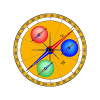Speaker
Aram Kotzinian
(INFN Turin)
Description
We present our calculations of the polarization- and transverse momentum dependent single hadron fragmentation functions (FF) and dihadron fragmentation functions (DiFF) using the most recent quark-jet model. In this extension of the model the complete description of a polarized quark state after each step of hadron formation was given, based on a self-consistent treatment of the quark polarization transfer. For the first time all eight leading twist quark-to-quark plus unpolarized hadron splitting functions are taken into account. The resulting integral equations and sum rules shortly discussed for the case of inclusive pion production. Next, we describe the Monte Carlo framework for polarized quark hadronization, and the methods used to extract both single and dihadron FFs from simulated samples. We present the results for these functions, as well as the corresponding analyzing powers. Our model analyzing powers: 1) for a single hadron production are large and have an opposite sign for favored and unfavored channels; 2) for two oppositely charged hadrons production in transversely polarized quark fragmentation are comparable in magnitude with single hadron ones; 3) for two oppositely charged hadrons production in longitudinally polarized quark fragmentation are much smaller in magnitude than those for the transversely. We also note that in general, different combinations of the fully unintegrated transverse polarization-dependent DiFFs enter into the azimuthal asymmetries for the dihadron production in semi-inclusive electron-positron annihilation and lepton nucleon scattering. This might potentially have significant implications for the phenomenological extractions of the transversity via interference fragmentation functions. Our model predicts a factor of two difference between the two definitions.
Primary author
Aram Kotzinian
(INFN Turin)

